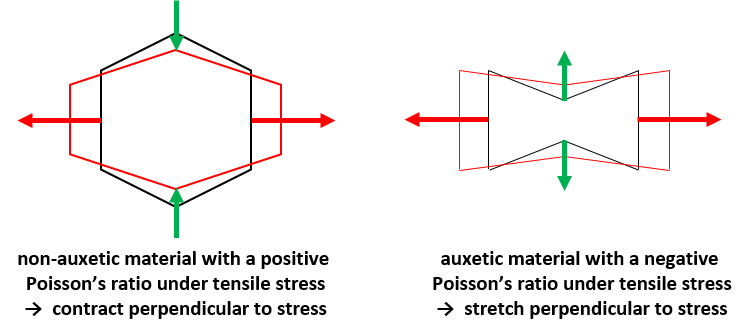Auxetic materials

Materials developed for aerospace applications have to meet a number of requirements such as high stiffness and strength, reduced weight, resistance to corrosion, radiation, vacuum and temperature extremes, low maintenance, and low costs. Therefore, composite materials are increasingly used for applications in space, aerial and maritime vehicles. These composite materials include glass, aramid, carbon fibres, polyethylene, and quartz with a variety of resins. The main advantage of composite materials in the ability to tailor their properties. Properties that have to be adjusted are shear strength and modulus, impact strength, energy absorption, fatigue resistance, and facile detection and repair of damaged parts. Many of those properties, foremost repair and impact strength, are poorly realised on today’s materials.
A promising class of materials comprising a number of properties mentioned above are auxetic materials (from Greek, auxesis, αύξεσις = increase). The term “auxetic” was used for the first time in 1991 by Evans [1]. Though the term “auxetic” is relatively new, auxetic behaviour has been known for over 100 years, although auxetic materials have not been given much attention until few decades ago. Auxetic materials have a negative Poisson’s ratio, ν. The Poisson’s ratio is defined as the negative ratio of lateral strain to the stretched longitudinal strain. Tensile deformation is determined as positive and compression deformation is determined as negative. As the formula of the Poisson’s ratio contains a minus sign, most known materials have a positive ratio reflecting a tendency to conserve volume [2]. According to the theory of elastic mechanics, ν is between 0 and 0.5. It is close to 0.3 for many materials and approximately 0.5 for rubbery materials. Looking at the microstructure, inter-atomic bonds in a material realign upon deformation. The material tries to maintain its density causing a contraction in the lateral direction. Materials with a high atomic packing density such as gold have a high Poisson’s ratio of 0.5, while materials which have a lower atomic packing density such a crystallite metals have a Poisson’s ratio of around 0.3.
Auxetic materials, in contrast, expand in the lateral direction when stretched longitudinally and contract for perpendicular compressive stress. In other words, auxetic materials become thicker when stretched and thinner as response to compression. They consist of numerous hinge-like cells that are joined together. The cells have a re-entrant geometry, i.e. under pressure, they expand in lateral direction. The word re-entrant refers to an angle in a polygon that is greater than 180° and therefore pointing inwards. The side-way expansion is responsible for the negative Poisson’s ratio of auxetic materials. A homogeneous, isotropic 3D solid has a potential Poisson’s ratio between -1.0 and 0.5. This range can be enlarged for anisotropic solids to more extreme values [3].
Project
Application of auxetic materials in aerospace has long been suggested by many authors. However, a detailed description of how to make use of auxetic materials and a direct comparison to traditional materials used today is lacking. For this reason a study was undertaken in order to identify auxetic materials particularly promising for space applications. This projects analyses the current status of materials used, comparing these materials to materials with auxetic properties.
References
- Evans, K. E., Nkansah, M. A., Hutchison, I. J., Rogers, S. C., Molecular Network Design. Nature, 1991, 353, 124. [link]
- Prawoto, Y., Integration of Mechanics into Materials Science Research: A Guide for Material Researchers in Analytical, Computational and Experimental Methods, 2013, published by Lulu Pr.
- Scarpa, F., Giacomin, J. A., Zhang, Y., Pastorino, P., Mechanical Performance of Auxetic Polyurethane Foam for Antivibration Glove Applications, Cellular Polymers, 2005, 24(5), 253-268. [link]